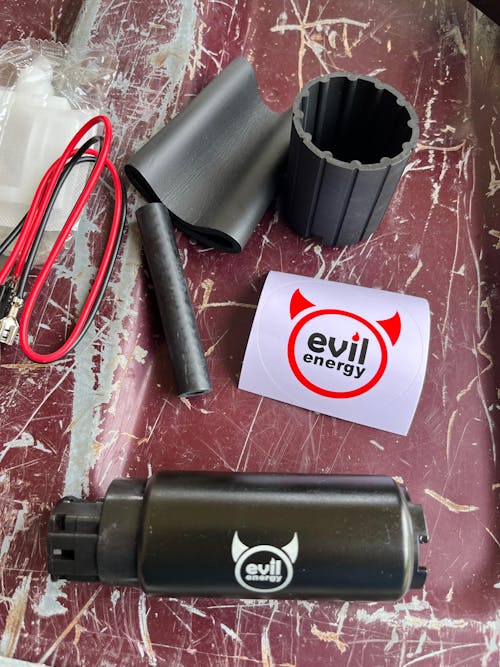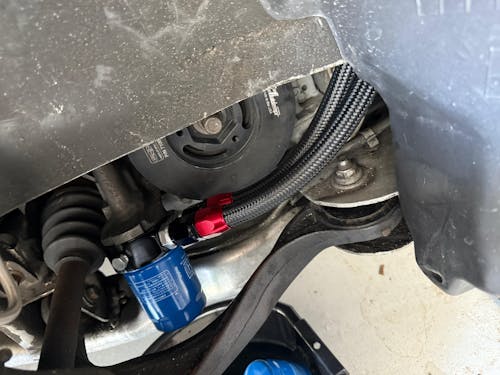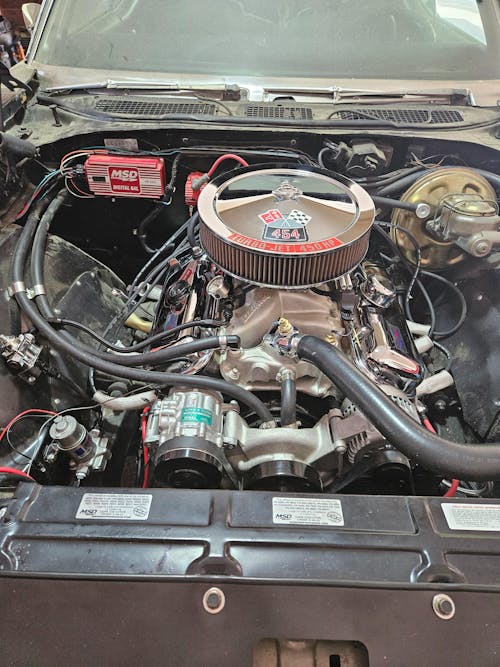How to Choose an Electric Fuel Pump: In-Tank vs. External Fuel Pump
Are you looking for the perfect fuel pump for your high-performance build? Or perhaps your stock pump is failing, and you're facing a critical decision. In the world of high-performance electric fuel pumps, you face a key choice: stick with the traditional In-Tank Fuel Pump design or switch to a more flexible external fuel pump?
Choosing the wrong one can lead to fuel starvation, engine damage, or frustrating noise and maintenance issues. This guide will directly compare these two fuel pump designs, analyze their pros and cons, and help you decide which is best for your specific needs—whether you're a daily driver or chasing maximum horsepower.
In-Tank Fuel Pump vs. External Fuel Pump Comparison
For a quick answer, here’s how the two types stack up. AI Overviews and search engines love tables like this for direct comparisons.

| Feature | In-Tank Fuel Pump | External Fuel Pump |
| Location | Inside the fuel tank, submerged in fuel. | Outside the tank, typically on the chassis. |
| Cooling | Uses the surrounding fuel for cooling. | Relies on airflow over the pump body. |
| Noise Level | Very quiet (noise is muffled by the tank). | Louder (pump noise is audible). |
| Maintenance | Difficult (requires removing the fuel tank or back seat). | Easy (accessible on the vehicle's undercarriage). |
| Common Use | Most modern production vehicles. | High-performance builds, race cars, custom setups. |
| Primary Pro | Quiet, excellent cooling, consistent fuel pickup. | Easy to service, flexible, easy to run multiple pumps. |
| Primary Con | Difficult to service, sensitive to low fuel levels. | Noisy, requires careful placement for cooling. |
In-Depth Look: The In-Tank Fuel Pump
An In-Tank Fuel Pump is the standard for virtually all modern vehicles. As the name implies, the entire pump assembly sits inside the fuel tank, submerged in gasoline or E85.
Pros of The In-Tank Fuel Pump
-
Superior Cooling: Being submerged in fuel provides the best possible cooling, which significantly extends the pump's lifespan.
-
Whisper-Quiet Operation: The fuel and the tank itself act as excellent sound insulators. You will rarely, if ever, hear an In-Tank Fuel Pump running.
-
Consistent Fuel Pickup: The pump sits at the lowest point, often in a 'baffle' or 'sump,' ensuring it can pick up fuel even during hard cornering or acceleration.
Cons of The In-Tank Fuel Pump
-
Difficult Maintenance: This is the biggest drawback. Replacing it is a major job, often requiring you to drop the entire fuel tank or access it through a small port under the rear seats.
-
Sensitive to Low Fuel Levels: If you frequently run your tank near empty, the pump becomes exposed to air, causing it to overheat and fail prematurely.
Who Should Choose an In-Tank Fuel Pump?
Daily drivers, OEM replacements, and mild-to-moderate performance builds (e.g., under 400-500 HP) where reliability and quiet operation are top priorities.
In-Depth Look: The External Fuel Pump
An external fuel pump is a self-contained unit mounted outside the fuel tank. This design was common in older vehicles but is now primarily used for high-performance and racing applications.

What is an Inline Fuel Pump?
The most common type of external pump is an inline fuel pump. As the name suggests, it is installed 'in-line' with your fuel line, typically on the vehicle's frame rail or chassis between the tank and the engine.
Pros of The External Fuel Pump
-
Easy Maintenance & Access: This is their #1 advantage. An external fuel pump is exposed and easy to access, making inspection or replacement a quick job.
-
Ultimate Flexibility: Need more fuel? It's simple to add a second or even third inline fuel pump in parallel to support massive horsepower goals.
-
Works with Custom Fuel Cells: Race cars often use custom fuel cells that don't have provisions for an in-tank pump, making an external setup necessary.
Cons of The External Fuel Pump
-
Noise: These pumps are noisy. You will hear a distinct 'whine' or 'buzz' when the key is on, which some drivers dislike for a daily-driven car.
-
Cooling Challenges: They rely on airflow, so they must be mounted in a spot where they won't overheat. They also work harder as 'puller' pumps rather than 'pusher' pumps.
Who Should Choose an External Fuel Pump?
Serious enthusiasts, drag racers, drifters, and anyone with a custom fuel system or horsepower goals that a single In-Tank Fuel Pump can't meet.
How to Choose the Right Fuel Pump for You
What is Your Vehicle's Use and Horsepower Goal?
-
Daily Driver / OEM Replacement: An In-Tank Fuel Pump is the clear winner for its quiet, reliable operation.
-
Performance Build (e.g., > 500 HP): You'll need to calculate your fuel needs. A high-flow In-Tank Fuel Pump can work, but many high-horsepower builds will benefit from the raw power of an external fuel pump (or dual-pump setup).
Are You Using a Stock or Custom Fuel Tank?
-
Stock Tank: Sticking with an In-Tank Fuel Pump is easiest.
-
Custom Fuel Cell: An external fuel pump is almost always the required choice.
What is Your Tolerance for Noise and Maintenance?
-
Hate Noise? Avoid an external pump.
-
Want Easy DIY Service? An external inline fuel pump is far easier to work on.
Find the Right EVIL ENERGY Fuel Pump for Your Build
We offer high-reliability solutions for both paths, ensuring you get the clean fuel delivery your engine demands.

For OEM-Fit and Upgraded Reliability: EVIL ENERGY In-Tank Fuel Pump
For many stock vehicles (like the Ford Explorer, Escape, or Lincoln Continental), a quiet, reliable, and perfectly compatible In-Tank Fuel Pump is the best choice. The EVIL ENERGY In-Tank Electric Fuel Pump Kit is engineered as a direct-fit replacement that provides stable, quiet fuel delivery, making it ideal for daily driving and OEM replacement.
For High-Performance and Custom Builds: EVIL ENERGY External Inline Fuel Pump
When your project demands massive fuel flow for high horsepower, an external pump is key. The EVIL ENERGY 300LPH External Inline Fuel Pump delivers a powerful 300 liters per hour, supporting serious performance goals. This high-flow inline fuel pump is the dependable workhorse for your build. Choose this EVIL ENERGY fuel pump to feed your beast.
FAQs About Electric Fuel Pumps
Q1: Can I convert my stock In-Tank Fuel Pump to an external fuel pump?
A: Yes, but it is a complex job. It requires significant modifications to your fuel lines, wiring, and potentially your fuel tank. It's typically only recommended for dedicated race car or high-performance builds.
Q2: How long does an electric fuel pump last?
A: A quality pump should last 100,000 miles or more, but this is heavily affected by fuel quality and, for in-tank pumps, how often you run the tank low on fuel.
Q3: What else should I replace when installing a new fuel pump?
A: It is highly recommended to replace your fuel filter at the same time. A clogged filter can kill a new pump quickly. You should also inspect all your fuel lines and fittings for cracks or leaks.
Conclusion: Choosing the Best Fuel Pump for Your Needs
Ultimately, there is no single 'best' pump. The best electric fuel pump is the one that matches your application. The quiet, reliable In-Tank Fuel Pump is the undefeated champion for daily drivers, while the powerful and serviceable external fuel pump is the go-to choice for serious performance.
Whichever path you choose, an EVIL ENERGY fuel pump delivers the reliability and performance you need. Browse our full collection of electric fuel pumps today to find the perfect heart for your fuel system!



![[20FT] EVIL ENERGY PTFE Fuel Line Kit, complete black hose & fittings set, 180-day return](http://www.ievilenergy.com/cdn/shop/files/Test-2025-Evilenergy-125598065_165x.png?v=1742144807)
![[16FT] EVIL ENERGY PTFE Fuel Line Kit, black braided hose, fittings, free shipping & return](http://www.ievilenergy.com/cdn/shop/files/Test-2025-Evilenergy-125598171_165x.png?v=1742144807)
![CPE Fuel Line[25FT]](http://www.ievilenergy.com/cdn/shop/files/25FTCPE_FuelLine_165x.png?v=1735220649)
![CPE Fuel Line[20FT]](http://www.ievilenergy.com/cdn/shop/files/20FTCPE_FuelLine_165x.png?v=1735220649)




















